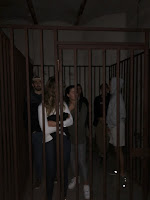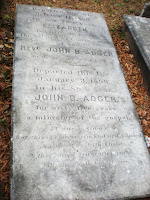 |
| The Old Charleston City Jail |
As we walked up we saw the dark, gloomy, Victorian styled, jail towering over us. I tried not to look in the windows for fear that if I looked up I would see a person staring back down at me. Outside our guide, Glenn Mckenzie, from Bulldog Tours met us outside. He was a character himself, he was extremely informative and a great storyteller.
 |
| Where the Guards Would Flog the Prisoners |
The jail had this straw type material on the floor that pretty much was a floor, a bed, and a bathroom all in one. But imagine having to share this cell with about 15 other people and that was about what it was like for the inmates in the Old Charleston City Jail. The jails excuse for not having these necessities is that they feared the prisoners would use them to rebel, which they had before but that is still no reason to deny people of simple necessities.
| The Buck and Gag Technique Used to Punish Prisoners of War. |
The local prisoners stayed crowded on the inside of the jail, and the prisoners of war simply lived in a tent-like camp outside. This time was the jails prime time for death, most of the death did not happen the way you would think, but actually, starvation and diseases killed many of the prisoners opposed to executions and things of that nature.
Walking up the stairs into the jail it's almost as if you just feel as if you are being watched the whole time. Sometimes you will see things out of the corner of your eyes like a sharp movement or even feel as if someone or something is grabbing you. It's something very strange to experience.
The Story of Lavinia Fisher
Lavana and her husband, Josh, were a part of a gang that would commit highway robbery around South Carolina. Lavinia was the eye candy of the operation, luring tired travelers into their hotel The Six Mile Hotel (named this because it is six miles outside of Charleston...wow how original), and when they fell asleep her and the gang would go in and rob them.
| Lavinia Fisher |
After being sentenced to death she and John attempted to escape. John made it down out of their cell but Lavinia did not, John could have escaped but did not because Lavinia did not...a true love story right there.
 |
| The Size of One of the Cells in Lavinia's Room. |
Where she was kept was very eerie and just looked as if it would be overcrowded something out of a horror movie. It was dark and cold and damp. You could have only imagined the hell the people there went through especially Lavinia being one of the only females and being so stunning.
People say that when walking by they will sometimes see her ghost or they will have close encounters with her. In which she is not ruthless and heartless like someone people would expect. She is asking, in fact, begging for help. This only makes you wonder more, what kind of horrors did Lavinia endure in that jail.
The Story Denmark Vesey
| Denmark Vesey |
He and a few of his friends planned a slave revolt, which would have been pretty violent, to say the least. The revolt was supposed to take place on July the 14th, he was arrested and hung even before July 14th arrived. He never got to partake in the revolt or anything like that because some of the slaves found out and then their masters found out. Which in turn lead to him and five of his friends to be arrested and taken to the Old Charleston City Jail on June 22nd.
When he nor his friends gave up anyone the state decided to execute these men. On July 2nd Denmark and his friends were hung, publicly to make a statement. If you revolt or plan one this is what will happen to you.
The Story of George Todd
| Doctor George Todd |
| Massachusettes 54th Regiment |
After the Massachusetts 54th Regiment was captured when they attacked Fort Wagner, most of the all African American legion was imprisoned at the Old Charleston Prison. Here there is a story told about one of the members that doctor Todd treated. The man had been shot in the chest, he was coughing up blood. But doctor Todd took it as the man spitting at him. He then proceeded to bucked and gag the man. (a picture of this is shown in the intro). Then the man was thrown outside in the cold mud, the man died pretty much drowning in his own blood. Todd saw no problem with it because the man was in the wrong.
Todd had his own way of doing things and was known to be cruel. Even his own Confederate people thought of him that way. He got what was needed to be done at the jail, but many people died in his infirmary. Making it one of the most haunted places in the jail, a lot of pain, a lot of sorrow took place in that infirmary you can feel it. It almost drains you right when you walk in.
The Story of William Marcus
 |
| The Cell of William Marcus |
His room was on the top floor of the prison. As soon as you walk in you get an immediate sense that you are being watched. The third floor is where they kept the worst of the worst because it was harder for them to escape and well Willam Marcus was that. He was executed shortly after his imprisonment.
In his cell, a year ago, I had my first paranormal experience. As we were all sitting there just listening to our guide speak we saw this shadow of a head appear on the wall behind our guide. We just thought it was someone behind me, but I turned around and no one was there. So we started ducking down trying to pinpoint exactly whos head this was. Until eventually we were all ducked down. The head was still there and as we went to get tell our tour guide the head ducked. Then as soon as our guide turned his back the head came back. It was as if it was toying with us. Ever since that room in the jail, I have believed in ghosts.
 |
| Class Picture Prior to the Jail |
The jail is not just a creepy place, but it is a place with stories. The stories of people who have lived there and died there all of which are equally important. The stories of the guards who have worked there, the doctors, the prisoners of war, everyone who has been in there, in that jail has a story. The jail tells it perfectly. Though this is not exactly a "shining point" in Charleston history it still tells a story and shows the transformation Charleston has gone through.


















